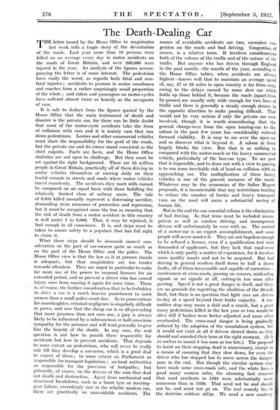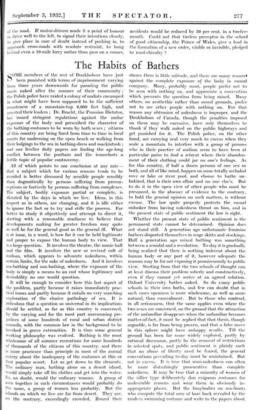The Death-Dealing Car
THE letter issued by the Home Office to magistrates last week tells a tragic story of the devastation of the roads. Last year more than 18 persons were killed on an. average every day in motor accidents on the roads of Great Britain, and over 200,000 were injured in the year. An analysis of the figures accom- panying the letter is of some interest. The pedestrian fares easily the worst, as regards both fatal and non- fatal injuries ; accidents to persons in motor omnibuses and coaches form a rather surprisingly small proportion of the whole ; and riders and passengers on motor-cycles have suffered almost twice as heavily as the occupants of cars.
It is safe to deduce from the figures quoted by the Home Office, that the main instrument of death and disaster is the private car, for there can be little doubt that most of the motor-cycle accidents take the form of collisions with cars and it is mainly ears that run down pedestrians. Lorries and other commercial vehicles must share the responsibility for the peril of the roads, but the private car and its owner stand convicted as the chief culprits. Facts are facts, and the Home Office statistics are not open to challenge. But they must be set against the right background. There are 45 million people in Great Britain, practically all of them driving in motor vehicles themselves or moving daily on their lawful errands in streets and roads where motor vehicles travel ceaselessly. The accidents.they meet with cannot be compared on an equal basis with those befalling the relatively limited class of railway users. The tale of 6,691 killed annually represent a distressing sacrifice, demanding stern measures of protection and repression, but it must be recognized none the less as meaning that the risk of death from a motor accident in this country is well under 1 in 6,000. That, it may be rejoined, is bad enough in all conscience. It is, and steps must be taken to assure safety to a populace that has full right to claim it.
What those steps should be demands earnest con- sideration on the part of car-owners quite as much as on the part of the Home Office and the police. The Home Office view is that the law as it at present stands is adequate, but that magistrates are too tender towards offenders. They are urged in particular to make far more use of the power to suspend licences for an extended period, and so prevent a driver who has caused injury once from causing it again for some time. There is, of course, the further consideration that to be forbidden to drive a car is a much heavier punishment to most owners than a small police-court fine. As to prosecutions for manslaughter, criminal negligence is singularly difficult to prove, and now that the cheap car is so all-pervading that more jurymen than not own one, a jury is always likely to be influenced by a subconscious or half-conscious sympathy for the prisoner and will tend generally to give him the benefit of the doubt. In any case, the real question is not how to punish those responsible for accidents but how to prevent accidents. That depends to some extent on pedestrians, who will never be really safe till they develop a car-sense, which is a good deal to expect of them ; to some extent on Parliament as responsible for transport legislation ; on local authorities as responsible for the provision of footpaths ; but primarily, of course, on the drivers of the cars that deal out death and destruction. Apart from mechanical and structural breakdown, such as a burst tyre or steering- gear failure, exceedingly rare in the reliable modern car, there are practically no unavoidable accidents. The causes of avoidable accidents are two, excessive con. gestion on the roads and bad driving. Congestion, of, course, is a relative term. It involves considerations both of the volume of the traffic and of the nature of the traffic. But anyone who has driven through England, in the past month—the month of the year, according to the Home Office tables, when accidents are always highest—knows well that to maintain an average speed of, say, 27 or 28 miles in open country is far from easy, owing to the delays caused by some slow car which holds up those behind it, because the roads (apart from, by-passes) are usually only wide enough for two lines of traffic and there is generally a steady enough stream in the opposite direction to make passing difficult. That would not be very serious if only the private car were involved, though it is worth remembering that the general change-over from the open touring-car to the saloon in the past few years has considerably reduced forward visibility. It is easy to see over the open car and so discover what is beyond it. A saloon in front largely blocks the view. But that is as nothing as compared with the motor-coach or the heavy commercial vehicle, particularly of the box-car type. To see past that is impossible, and to draw out with a view to passing is to run some inevitable risk of head-on collision with an approaching car. The multiplication of these heavy. vehicles is one of the gravest menaces of the roads. Whatever may be the economics of the Salter Report proposals, it is incontestable that any restrictions tending to reduce the number of lorries and heavy transport vans on the road will mean a substantial saving of human life.
But in the end the one essential reform is the elimination of bad driving. In that term must be included incom- petent as well as careless driving, and incompetent drivers will unfortunately be ever with us. The control of a motor-car is an expert accomplishment, and some people will never master it. They are not hopeless enough to be refused a licence, even if a qualification test were demanded of applicants, but they lack that road-sense which is only partly a matter of experience, for it involves some quality innate and not to be acquired. But bad driving in general resolves itself down to half a dozen faults, all of them inexcusable and capable of correction— carelessness at cross-roads, passing on corners, misleading signals or no signals at all, cutting-in too soon after passing. Speed is not a great danger in itself, and there are no grounds for regretting the abolition of the 20-mile limit, -but there is no question that light cars are driven to-day at a speed beyond their brake capacity. A too- sudden stop may mean a skid and a smash, but a great many pedestrians killed in the last year or two would be alive still if brakes were better adjusted and more often overhauled. The cross-road danger is being gradually reduced by the adoption of the roundabout system, but it would not exist at all if drivers slowed down as they should and sounded their horn at the right moment. (It is as useless to sound it too soon as too late.) The proposal to insist on their stopping dead is unnecessary, except as a means of ensuring that they slow down, for even the driver who has stopped has to move across the danger- zone in the end. But though the circular system may have made some cross-roads safe, and the white lines a good many corners safer, the alarming fact remains that road accidents in 1931 were substantially more numerous than in 1930. That need not be and should not be, and must not go on. The real remedy lies in the doctrine noblesse oblige. We need a new courtesy of the road. If motor-drivers made it a point of honour to drive well to the left, to signal their intentions clearly, to give place in case of doubt instead of pushing in, to approach cross-roads with resolute restraint, to hang behind even a 10-mile lorry rather than pass on a corner, accidents would be reduced by 50 per cent. in a twelve- month. Could not that tireless preceptor in the school of good citizenship, the Prince of Wales, give a lead in the formation of a new order, visible or invisible, pledged to road-chivalry ?































 Previous page
Previous page